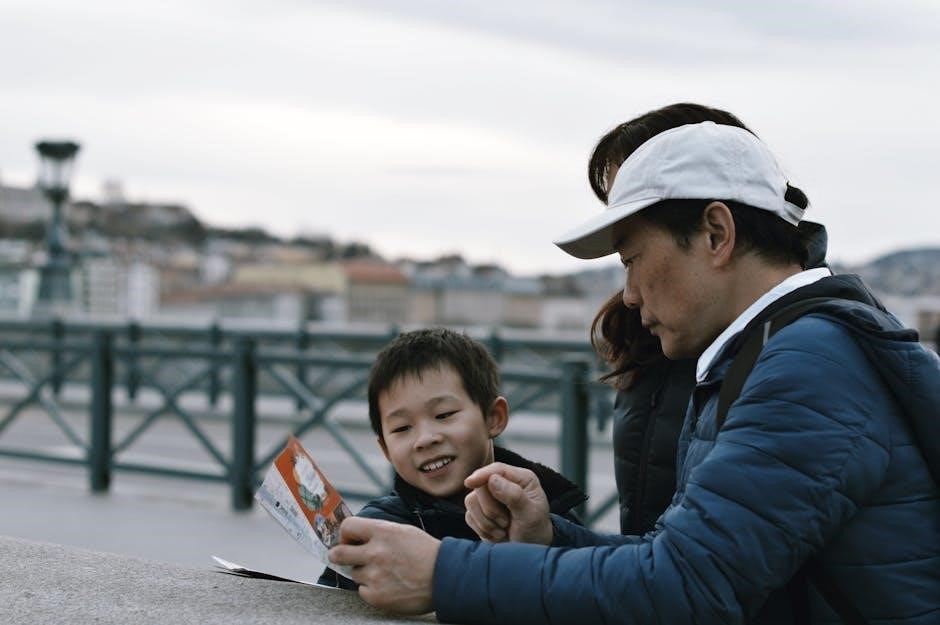Kyoto, the cultural heart of Japan, captivates visitors with its historic temples, vibrant traditions, and serene landscapes. A must-visit destination for any traveler.
Overview of Kyoto’s Cultural Significance
Kyoto is the cultural heart of Japan, preserving centuries of traditions, art, and history. Once the capital, it is home to iconic temples like Kinkaku-ji and Kiyomizu-dera, showcasing its spiritual depth. The city’s vibrant culture, from geisha performances in Gion to traditional tea ceremonies, reflects its timeless charm. Kyoto’s commitment to historical preservation makes it a living museum of Japanese heritage, offering a glimpse into the nation’s soul.
Why Visit Kyoto?
Kyoto offers an unparalleled journey through Japan’s cultural and natural beauty. From the iconic cherry blossoms and autumn foliage to historic landmarks like Arashiyama Bamboo Grove, the city captivates all senses. Experience authentic traditions, such as tea ceremonies and geisha culture, while exploring its serene gardens and bustling food streets. Whether seeking adventure or tranquility, Kyoto promises unforgettable memories, making it a must-visit destination for any traveler.
Best Time to Visit Kyoto
Kyoto is best visited in spring and autumn for stunning cherry blossoms and vibrant foliage, though these seasons attract larger crowds.
Seasonal Highlights: Cherry Blossoms and Autumn Leaves
Kyoto’s natural beauty shines during spring and autumn. Cherry blossoms bloom in late March to early April, creating stunning pink landscapes at spots like Philosopher’s Path and Maruyama Park. Autumn foliage peaks in November, with vibrant red and orange leaves transforming Arashiyama Bamboo Grove and Kinkaku-ji. These seasons offer unforgettable experiences, from picnics under blossoms to illuminated temples during autumn evenings. Plan your visit to coincide with these highlights for an unforgettable journey through Kyoto’s seasonal charm.
Weather and Crowd Avoidance Tips
Kyoto’s weather varies significantly by season, with hot, humid summers and cool winters. To avoid crowds, consider visiting popular spots early in the morning or later in the evening. Spring and autumn, while stunning, attract large numbers of tourists. Using public transportation or rental bikes can help navigate busy areas efficiently. Plan your itinerary around these tips to enjoy a more relaxed and immersive experience exploring Kyoto’s iconic sites and hidden gems.
Must-See Attractions in Kyoto
Kyoto’s iconic landmarks, such as Kinkaku-ji and Kiyomizu-dera, offer breathtaking views and cultural insights. Explore Fushimi Inari Taisha’s torii gates and Arashiyama Bamboo Grove for unforgettable experiences.
Famous Temples: Kinkaku-ji and Kiyomizu-dera
Kinkaku-ji, the Golden Pavilion, dazzles with its gold-leaf-covered exterior and serene garden. Kiyomizu-dera, a UNESCO World Heritage site, offers breathtaking views from its wooden stage. Both temples embody Kyoto’s spiritual essence, attracting millions yearly. Visit Kinkaku-ji in the morning for a tranquil atmosphere and Kiyomizu-dera at sunset for stunning vistas. These iconic landmarks are a testament to Kyoto’s rich history and cultural heritage, making them unmissable for any traveler.
Historic Landmarks: Arashiyama Bamboo Grove and Fushimi Inari Taisha
Arashiyama Bamboo Grove captivates visitors with its towering bamboo stalks and serene walking paths. Nearby, the iconic Togetsukyo Bridge offers stunning views. Fushimi Inari Taisha, famous for its thousands of vermilion torii gates, is a must-visit Shinto shrine; Hike the mountain trails to explore the gates and enjoy panoramic views of Kyoto. Both landmarks showcase Kyoto’s natural beauty and spiritual significance, making them unforgettable destinations for any traveler.
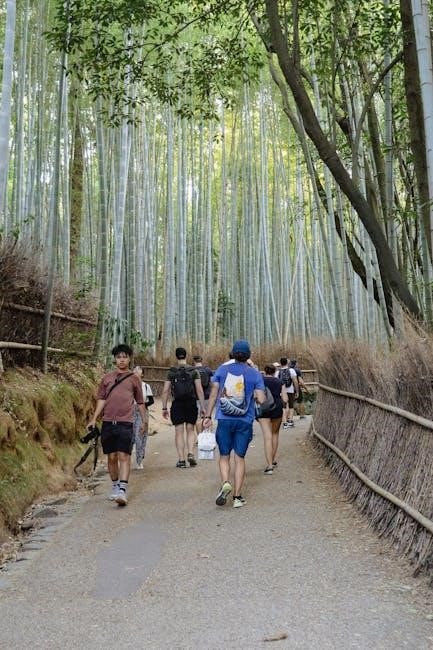
Cultural Experiences in Kyoto
Immerse yourself in Kyoto’s rich traditions by attending a tea ceremony, witnessing geisha performances, or participating in calligraphy and flower arrangement workshops.
Tea Ceremonies and Geisha Culture
Discover Kyoto’s timeless traditions by attending a tea ceremony, where the art of preparing matcha reflects tranquility and mindfulness. Geisha culture offers a glimpse into Japan’s refined entertainment, with performances showcasing traditional dance and music. These experiences provide a deeper connection to Kyoto’s heritage and its enduring elegance.
Traditional Festivals and Events
Kyoto’s festivals offer captivating glimpses of its rich cultural heritage. The Gion Matsuri, famous for its ornate floats, and the Jidai Matsuri, showcasing historical costumes, are must-experience events. These vibrant celebrations highlight Kyoto’s enduring traditions, blending history, religion, and community spirit. Attending these events provides a unique opportunity to immerse yourself in the city’s cultural essence and witness its timeless charm firsthand.

Dining in Kyoto
Kyoto is a culinary gem, offering authentic Japanese flavors and refined dining experiences. From traditional kaiseki meals to modern eateries, the city caters to every palate.
Must-Try Local Cuisine: Kaiseki and Shojin-ryori
Kaiseki, a multi-course meal emphasizing local, seasonal ingredients, offers a refined taste of Kyoto’s culinary art. Shojin-ryori, Buddhist vegetarian cuisine, features tofu, mushrooms, and sesame, showcasing simplicity and flavor. Both reflect Kyoto’s dedication to tradition and harmony with nature. These dishes are perfect for experiencing the city’s gastronomic depth and cultural heritage. Be sure to try them at renowned restaurants in Gion or historic temples for an authentic dining experience.
Best Restaurants and Food Streets
Kyoto’s dining scene is a culinary gem, with iconic spots like Gion, known for its high-end kaiseki restaurants, and Nishiki Market, offering street food delights. Pontocho Alley is another must-visit, lined with tiny eateries serving everything from sushi to yakitori. For a local experience, explore Kyoto’s food streets, where traditional flavors meet modern twists. Don’t miss the chance to dine at these historic eateries to fully immerse yourself in Kyoto’s gastronomic culture.
Transportation in Kyoto
Kyoto offers efficient transport options, including trains, buses, and rental bikes. Prepaid IC cards simplify travel, while the city’s grid layout makes navigation straightforward for visitors.
Getting Around: Trains, Buses, and Rental Bikes
Kyoto’s transportation network is efficient and accessible. Trains are the most convenient option, with JR lines like Nara and Sagano connecting major attractions. The Kyoto Subway system complements the JR network, while buses cover areas trains don’t reach. Rental bikes are popular for shorter distances, offering flexibility to explore at your own pace. Prepaid IC cards like ICOCA or Suica simplify travel on public transport. Many stations and buses also offer English support, making navigation easier for visitors.
Using the JR Pass and Prepaid IC Cards
The JR Pass is ideal for long-distance travel to Kyoto, offering unlimited rides on JR trains. Prepaid IC cards like ICOCA or Suica are perfect for local transport, including trains, buses, and subways. These cards can be purchased at most stations and refilled as needed. They simplify payments and often include discounts for tourists. Additionally, many IC cards can be used nationwide, making them a convenient option for travelers exploring beyond Kyoto.
Budgeting for Your Kyoto Trip
Plan for daily expenses of $80-$150 per person, covering accommodation, meals, entry fees, and transport. A week in Kyoto could cost around $500-$1,000. Budget wisely!
Cost Breakdown: Accommodation, Food, and Activities
Average daily expenses in Kyoto range from $80 to $150 per person. Accommodation varies from $30 for hostels to $200 for luxury hotels. Meals cost $10-$20 for casual dining and up to $100 for high-end kaiseki. Temple entry fees are $5-$10, while guided tours can range from $50 to $100. Transportation costs around $2-$5 for public transit. Budget $500-$1,000 for a week, depending on your travel style.
Money-Saving Tips for Travelers
Plan ahead by purchasing prepaid IC cards for public transport. Opt for budget-friendly accommodations like hostels or guesthouses. Eat at local eateries or street food stalls for affordable meals. Utilize free temple entry times or combination tickets for discounts. Avoid peak travel seasons to save on lodging. Consider group tours to split costs. Use cashback apps or travel rewards for bookings. Carry reusable items to reduce single-use purchases.

Day Trips from Kyoto
Explore nearby cities like Nara, famous for its deer and Todai-ji Temple, or Osaka, known for its vibrant food and entertainment scene. Uji, with its green tea plantations and Byodo-in Temple, is another charming option. All are easily accessible by train, offering a day filled with history, culture, and natural beauty.
Exploring Nara and Osaka
Nara, a historic city, is home to the iconic Todai-ji Temple and friendly deer that roam Nara Park. Osaka, known for its vibrant atmosphere, offers delicious street food in Dotonbori and stunning views from Osaka Castle. Both cities are easily accessible by train from Kyoto, making them perfect for a day trip filled with history, culture, and culinary delights.
Visiting the Miyama and Kurama Regions
Miyama and Kurama offer tranquil escapes from Kyoto’s bustling streets. Miyama showcases traditional thatched-roof houses and picturesque rural landscapes, while Kurama is famed for its hot springs and scenic hiking trails; Both regions provide a serene atmosphere, perfect for reconnecting with nature and experiencing Japan’s countryside charm.
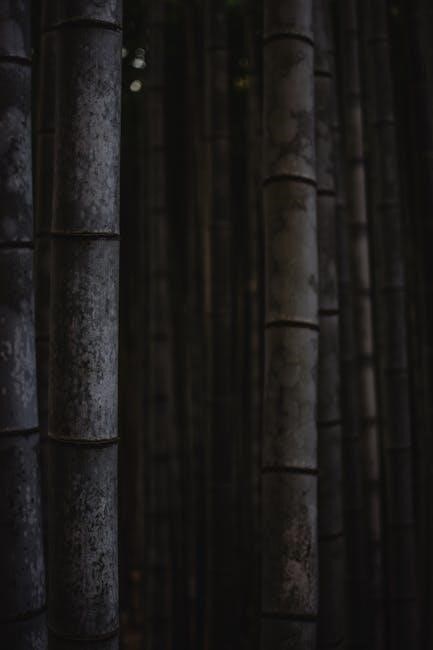
Guided Tours in Kyoto
Guided tours in Kyoto offer expert insights into its cultural and historical treasures. Choose from various options, including walking, cycling, or themed tours, tailored to your interests.
Choosing the Right Tour Guide for Your Needs
Selecting the ideal tour guide in Kyoto ensures a personalized and enriching experience. Consider guides fluent in your language, with deep local knowledge and excellent reviews. Ensure their expertise aligns with your interests, whether it’s history, culture, or cuisine. Some guides specialize in themed tours, such as temple walks or geisha culture. Check for certifications and read testimonials to find a guide who matches your travel style and budget for an unforgettable journey through Kyoto.
Pros and Cons of Independent vs. Group Tours
Independent tours offer flexibility and cost savings but require self-planning. Group tours provide structure, expert insights, and convenience but may lack personalization. Consider your preferences and budget to decide.Independent tours offer flexibility and cost savings but require self-planning. Group tours provide structure, expert insights, and convenience but may lack personalization. Consider your preferences and budget to decide.
Seasonal Activities in Kyoto
Kyoto offers seasonal delights like spring illuminations and autumn foliage, winter hot springs, and summer fire festivals, each highlighting the city’s natural beauty and cultural charm.
Spring and Autumn Illuminations
Kyoto’s spring and autumn illuminations are breathtaking. During cherry blossom season, temples and gardens are adorned with soft pink lights, creating magical ambiance. In autumn, vibrant red and orange leaves are illuminated, highlighting the city’s natural beauty. Popular spots like Kiyomizu-dera and Arashiyama Bamboo Grove offer stunning displays. These events attract millions, showcasing Kyoto’s seasonal charm and cultural heritage through dazzling light displays and serene landscapes.
Winter Hot Springs and Summer Fire Festivals
Kyoto offers unique seasonal experiences. In winter, relax in natural hot springs (onsen) at scenic spots like Arashiyama and Kurama. Summer brings vibrant fire festivals, such as the iconic Daimonji bonfire on Mount Wakakusa and fireworks along the Katsura River. These events showcase Kyoto’s seasonal charm, blending nature, culture, and tradition, making them unforgettable experiences for visitors exploring the city’s diverse attractions.
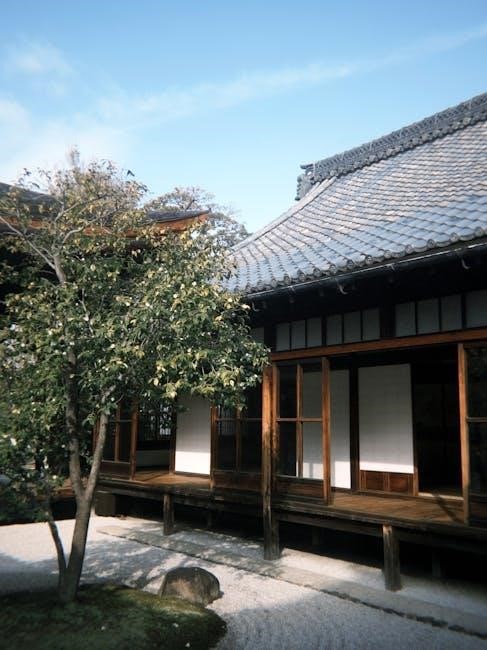
Shopping in Kyoto
Kyoto blends traditional and modern shopping experiences. Explore historic Gion for artisanal crafts, or visit Kawaramachi for trendy boutiques and vibrant street life, perfect for all shoppers.
Traditional Souvenirs: Kimono and Handicrafts
Kyoto is renowned for its traditional souvenirs, with kimonos being a timeless favorite. Handicrafts like pottery, lacquerware, and wooden carvings showcase local artisans’ skill. Visit Gion or Ginkaku-ji to explore these treasures. These items are not only beautiful but also carry deep cultural significance. Many shops offer custom-made kimonos, perfect for memorable gifts or personal keepsakes. Don’t forget to check for authenticity and quality when shopping for these unique pieces of Kyoto’s heritage.
Modern Shopping Districts: Gion and Kawaramachi
Gion, known for its geisha culture, also offers modern shopping experiences with boutiques and cafes. Kawaramachi, a lively district, features contemporary shops, restaurants, and entertainment. Both areas blend tradition with modernity, providing unique shopping experiences. Stroll through Gion’s cobblestone streets for exclusive goods or explore Kawaramachi’s trendy vibe. These districts are perfect for finding a mix of traditional and modern souvenirs, making them must-visit spots for shoppers in Kyoto.
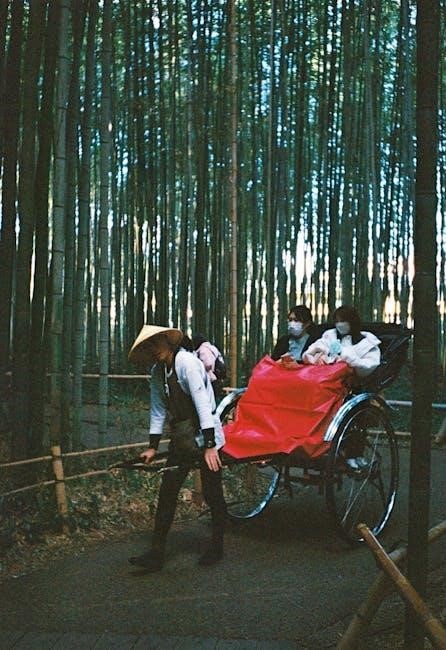
Cultural Etiquette in Kyoto
Respect traditions by bowing, removing shoes, and dressing modestly at temples. Follow local customs to preserve Kyoto’s heritage and ensure a harmonious experience for all visitors.
Temple and Shrine Manners
Understanding temple and shrine etiquette is essential for a respectful visit. Bow upon entry, cleanse hands at water basins, and avoid tipping. Dress modestly, remove shoes indoors, and keep voices low. Refrain from touching sacred objects or taking photos inside main halls. Follow instructions from staff and respect restricted areas. By observing these customs, you honor Kyoto’s traditions and enhance your cultural experience. Carry a pocket Wi-Fi for seamless navigation and guidance.
Respecting Local Customs and Traditions
Respecting Kyoto’s customs enhances your experience and fosters goodwill with locals. Remove shoes indoors, bow respectfully, and dress modestly. Participate thoughtfully in tea ceremonies and festivals, understanding their cultural significance. Avoid disrupting traditions or taking inappropriate photos. Embrace the city’s heritage by learning basic Japanese phrases and following local norms. Your consideration will enrich your visit and honor Kyoto’s timeless traditions.
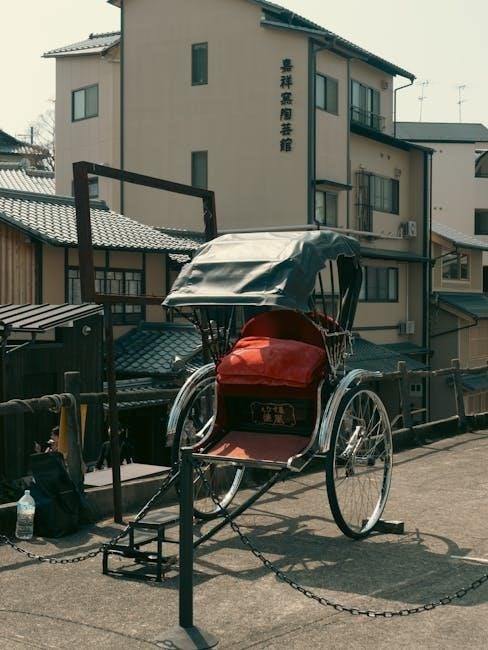
Photography Tips for Kyoto
Kyoto’s iconic landmarks and scenic views offer endless photography opportunities. Capture cherry blossoms and autumn leaves during golden hours for stunning lighting and vibrant colors.
Capturing Iconic Landmarks and Scenic Views
Kyoto’s iconic landmarks, such as Kinkaku-ji and Kiyomizu-dera, offer breathtaking backdrops for photography. Timing is key—visit during golden hours for soft lighting. The Arashiyama Bamboo Grove and Fushimi Inari Taisha’s torii gates are stunning subjects. Experiment with angles, reflections, and seasonal elements like cherry blossoms or autumn leaves. Wide-angle lenses are ideal for capturing vast panoramas, while close-ups highlight intricate details. Patience and timing ensure unforgettable shots of Kyoto’s natural and cultural beauty.
Best Times for Photography
Kyoto’s photography opportunities shine during spring (March–May) and autumn (November–December), when cherry blossoms and vibrant foliage create stunning scenes. Early mornings offer soft, golden light, while late afternoons capture dramatic skies. Winter (December–February) provides serene landscapes with snow-covered temples, while summer (June–August) highlights lush greenery. Timing visits during these seasons ensures captivating shots of Kyoto’s iconic landmarks and scenic beauty. Plan around these periods for unforgettable photography experiences.
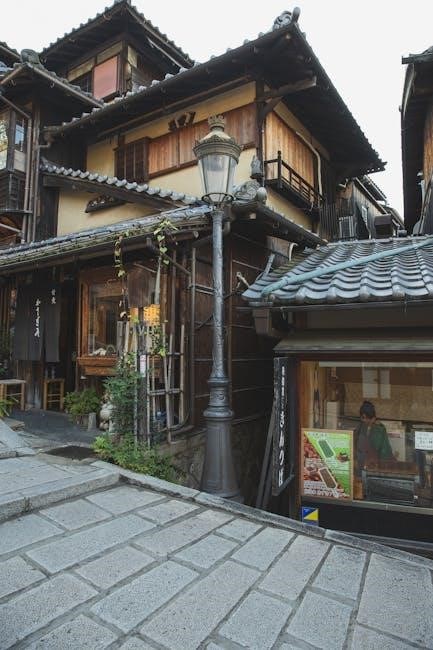
Nightlife in Kyoto
Kyoto’s nightlife offers a blend of traditional tea houses, intimate bars, and vibrant izakayas. Explore Gion for geisha culture or Pontocho Alley for unique evening experiences and local drinks.
Bars, Pubs, and Nightlife Districts
Kyoto’s nightlife scene, while subdued compared to Tokyo, offers charming bars and pubs. Gion’s traditional tea houses and Pontocho Alley’s narrow streets are perfect for evening exploration. The city also features modern cocktail bars and izakayas, blending traditional and contemporary vibes. Visitors can enjoy craft beers, sake, and local whiskey in intimate settings, making Kyoto’s nightlife a unique and memorable experience for travelers.
Traditional Evening Entertainment
Kyoto offers a glimpse into Japan’s rich cultural heritage through traditional evening performances. Gion, the famous geisha district, comes alive with exclusive tea houses featuring classical music, dance, and theater. Visitors can experience kabuki plays or traditional Noh performances, while public shows at venues like Gion Corner provide accessible insights into these ancient arts. These evening events showcase Kyoto’s timeless charm and deep cultural roots, making them unforgettable experiences for travelers.
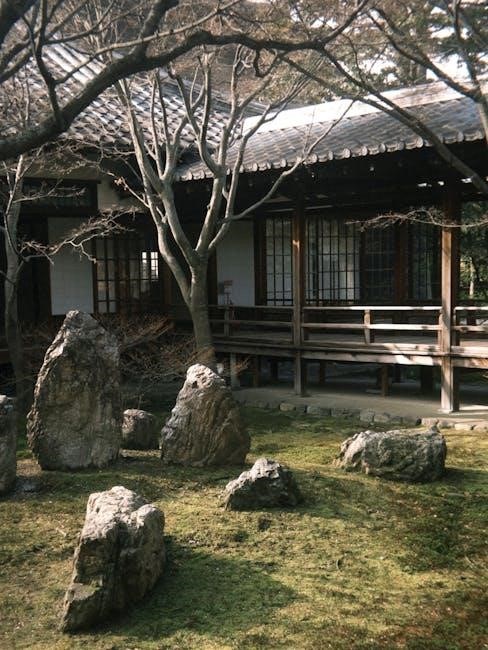
Accommodation in Kyoto
Kyoto offers diverse lodging options, from traditional ryokans to modern hotels. Stay in historic Gion, vibrant Kawaramachi, or serene Arashiyama for unique experiences tailored to every traveler’s preference and budget.
Choosing the Right Neighborhood to Stay
Kyoto’s neighborhoods offer distinct experiences. Gion is ideal for traditional culture and geisha sightings, while Kawaramachi provides modern shopping and dining. Arashiyama offers serene natural surroundings, and areas near Kyoto Station are perfect for convenient access to transportation. Staying in Central Kyoto ensures proximity to major attractions, whereas the Philosopher’s Path area offers a peaceful, scenic environment. Choose based on your preferences for culture, convenience, or tranquility.
Hotel, Ryokan, and Hostel Options
Kyoto offers diverse accommodations catering to all preferences. Hotels provide modern comforts, often located in central areas like Gion or near Kyoto Station. Ryokans, traditional Japanese inns, offer a unique cultural experience with futon beds and kaiseki meals. Hostels are budget-friendly, ideal for backpackers, with shared spaces fostering social interactions. Each option ensures a memorable stay, blending convenience, tradition, and affordability to suit every traveler’s needs and budget.
Kyoto is a must-visit destination, blending rich cultural heritage with breathtaking natural beauty. Explore historic temples, vibrant traditions, and delicious cuisine. Plan thoughtfully to make the most of your journey.
Final Tips for Making the Most of Your Kyoto Tour
Plan ahead to maximize your time, respecting cultural norms at temples and shrines. Use public transport or rent bikes for easy navigation. Savor local cuisine and engage with traditional experiences like tea ceremonies. Don’t miss seasonal highlights like cherry blossoms or autumn foliage. Budget wisely, considering entry fees and dining costs. Carry cash for smaller shops and vendors. Lastly, embrace flexibility and immerse yourself in Kyoto’s serene beauty and rich heritage for an unforgettable journey.
